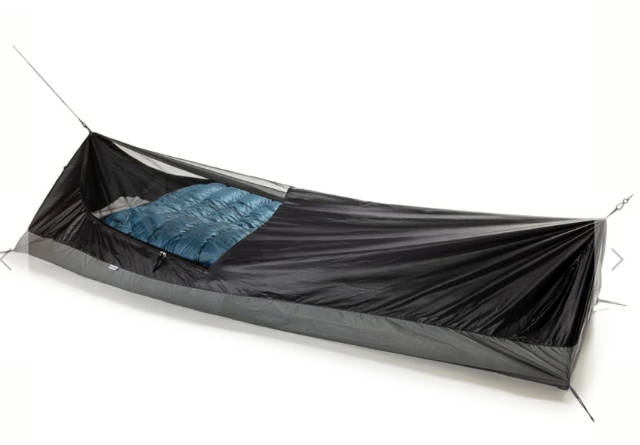Floorless tents and shelters provide an ultralightweight option for backpackers who want to significantly reduce their backpacking gear weight. While that weight reduction might sound quite attractive, in most cases you’ll still want some form of insect protection like a bivy sack and/or ground protection, like a ground cloth or bathtub floor to protect your gear from dirt and moisture. The weight of those added components will whittle away some of the potential weight savings but you can probably still reduce your shelter weight, depending on the components you choose which will most likely include:
- a tent rainfly or tarp
- insect protection, if required, in the form of a bivy sack or net-tent
- ground moisture protection in the form of a plastic sheet, ground cloth, or bathtub floor.
When it comes to a tent rainfly or tarp, there are a number of different approaches available including the use of a modular double-wall tent, a modular single-wall tent shelter system, or a flat (rectangular) tarp or shaped tarp like a pyramid.
1. Modular Double Wall Tent

You can use a modular double-wall tent, like a Durston X-Mid 1 Rainfly or the Tarptent Notch Rainfly, and just use the exterior rainfly portion while leaving the inner tent at home. If you already own such a tent, you can start experimenting with using a floorless tent without any extra cost or delay. This can be an attractive option when insect protection is not necessary and a plastic or ultralight ground sheet can suffice for ground and moisture protection.
However, if insect and ground moisture protection is needed, it can be hard to save much weight over using the inner tent already supplied with the rainfly if you already use an ultralight tent with a lightweight inner tent. For example, the inner tent on the Durston X-Mid 1 weighs 10.7 oz, which makes it difficult to slash much weight, even if you switch to an ultralight bivy sack and a plastic groundsheet.
2. Modular Single Wall Tent

Alternatively, you can invest in a modular single-wall pyramid tarp like a Mountain Laurel Designs Solomid XL or the Hyperlite Ultamid-2 or a modular shaped tarp system like the SlingFin Splitwing Shelter Bundle and augment it with an ultralight mesh bivy sack and ground cloth, either plastic sheeting or a bathtub floor.
The advantage of this approach is that you can upgrade with a fitted inner tent, like the Ultamid 2 Half Insert if later you decide you prefer having a more livable inner tent that provides insect and ground moisture protection. Many single-wall pyramid tarp manufacturers provide this option when purchasing a mid or as an add-on including Mountain Laurel Designs, Hyperlite Mountain Gear, Seek Outside, MSR, and Black Diamond.
3. Flat Tarp or Shaped Tarp

Another option is to use a flat tarp or a shaped tarp, adding a bivy sack for insect protection and a groundsheet or bathtub floor. This often provides the most effective way to shave gear weight but requires the biggest transition if you’re used to using a tent. The biggest weight-saving in this scenario likely be the weight of the rainfly, particularly if you choose one made out of an ultralight material like Dyneema
Some shaped tarps are also available with perimeter bug netting like the 9.8 oz Gossamer Gear DCF Whisper and the Six Moon Designs Deschutes Plus, and just require using some form of ground and moisture protection to turn into a complete shelter system.
Insect Protection
Insect protection is often a necessity when camping under a rainfly or tarp, but not always. It can also provide some protection against larger bothersome animal life like snakes, lizards, or scorpions that may be attracted to your body heat.

Ultralight backpackers often opt for an ultralight bivy sack for insect protection, which is entirely made with mesh or has a mesh window over the head and a breathable top fabric. Most ultralight bivy sacks are not waterproof and must be used with some sort of waterproof ground sheet, although there are exceptions including the 7.3 oz Katabatic Gear Pinon Bivy and 7.3 oz Bristlecone Bivy Sacks which have waterproof floors.
I’ve used bivy sacks quite extensively and enjoy sleeping in one, but they’re not everyone’s cup of tea in terms of livability. If more interior space is desired, you can try a larger Net-tent like the 6.5 oz Mountain Laurel Designs Bug Bivy or the 11 oz Six Moon Designs Serenity NetTent, which have the added benefit of having waterproof floors. They’re essentially the same as the inner tents available with modular single-wall tents, but are not wed to any one tent and can be used with a wide variety of other single-wall tents or tarps.
Ground Protection

Ground protection, particularly moisture protection is usually a requirement when using a floorless tent or shelter. It can take several forms from a durable plastic ground sheet or a tyvek ground sheet to a full bathtub floor which has sidewalls to protect against running or pooling water. All three benefit from good campsite selection skills in order to keep you and your gear dry.
See also:
SectionHiker is reader-supported. We only make money if you purchase a product through our affiliate links. Help us continue to test and write unsponsored and independent gear reviews, beginner FAQs, and free hiking guides.
